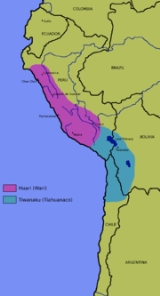
Huari Culture
Encyclopedia
- This article is about the historical civilization and city located near present-day Ayacucho. For the Province of the Ancash RegionAncash RegionAncash is a region in northern Peru. It is bordered by the La Libertad region on the north, the Huánuco and Pasco regions on the east, the Lima region on the south, and the Pacific Ocean on the west. Its capital is the city of Huaraz, and its largest city and port is Chimbote...
in PeruPeruPeru , officially the Republic of Peru , is a country in western South America. It is bordered on the north by Ecuador and Colombia, on the east by Brazil, on the southeast by Bolivia, on the south by Chile, and on the west by the Pacific Ocean....
, see Huari ProvinceHuari ProvinceThe Huari Province is one of twenty provinces of the Ancash Region in Peru. The famous Chavín de Huantar archaeological site is located in this province.-Political division:Huari is divided into sixteen districts, which are:-External links:...

Andes
The Andes is the world's longest continental mountain range. It is a continual range of highlands along the western coast of South America. This range is about long, about to wide , and of an average height of about .Along its length, the Andes is split into several ranges, which are separated...
and coastal area of modern-day Peru
Peru
Peru , officially the Republic of Peru , is a country in western South America. It is bordered on the north by Ecuador and Colombia, on the east by Brazil, on the southeast by Bolivia, on the south by Chile, and on the west by the Pacific Ocean....
, from about CE 500 to 1000. (The Wari culture is not to be confused with the modern ethnic group and language known as Wari'
Wari'
The Waricaca, also known as the Pakaa Nova, are an Amerindian nation indigenous to the Amazon rainforest. They are native to the state of Rondônia, Brazil and were first seen by European settlers at the shores of the river Pakaa Nova, which is a right-bank-tributary of the Mamoré River...
, with which it has no known link.) Wari
Wari ruins
The Wari Ruins are located near Quinua, in the Huanta Province, Ayacucho Region, Peru at an altitude 2770 m above sea-level. These ruins are all that is left of Wari, the capital city of the Wari ....
, as the former capital city was called, is located 11 km (6.8 mi) north-east of the modern city of Ayacucho
Ayacucho
Ayacucho is the capital city of Huamanga Province, Ayacucho Region, Peru.Ayacucho is famous for its 33 churches, which represent one for each year of Jesus's life. Ayacucho has large religious celebrations, especially during the Holy Week of Easter...
, Peru. This city was the center of a civilization that covered much of the highlands and coast of modern Peru
Peru
Peru , officially the Republic of Peru , is a country in western South America. It is bordered on the north by Ecuador and Colombia, on the east by Brazil, on the southeast by Bolivia, on the south by Chile, and on the west by the Pacific Ocean....
. The best-preserved remnants, beside the Wari Ruins
Wari ruins
The Wari Ruins are located near Quinua, in the Huanta Province, Ayacucho Region, Peru at an altitude 2770 m above sea-level. These ruins are all that is left of Wari, the capital city of the Wari ....
, are the recently discovered Northern Wari ruins near the city of Chiclayo, and Cerro Baul in Moquegua
Moquegua
Moquegua is a city in southern Peru, located in the Moquegua Region, of which it is the regional capital. It is also capital of Mariscal Nieto Province and Moquegua District. It is located 1144 kilometers south from the capital city of Lima.-History:...
. Also well-known are the Wari ruins of Pikillaqta ("Flea Town"), a short distance south-east of Cuzco en route to Lake Titicaca
Lake Titicaca
Lake Titicaca is a lake located on the border of Peru and Bolivia. It sits 3,811 m above sea level, making it the highest commercially navigable lake in the world...
.
Early on, the Wari expanded their territory to include the ancient oracle
Oracle
In Classical Antiquity, an oracle was a person or agency considered to be a source of wise counsel or prophetic predictions or precognition of the future, inspired by the gods. As such it is a form of divination....
center of Pachacamac
Pachacamac
The temple of Pachacamac is an archaeological site 40 km southeast of Lima, Peru in the Valley of the Lurín River. Most of the common buildings and temples were built c...
, though it seems to have remained largely autonomous. Later the Wari became dominant in much of the territory of the earlier Moche
Moche
'The Moche civilization flourished in northern Peru from about 100 AD to 800 AD, during the Regional Development Epoch. While this issue is the subject of some debate, many scholars contend that the Moche were not politically organized as a monolithic empire or state...
and later Chimu cultures. The reason for this expansion has been debated; it is believed to have been be driven by religious conversion, military conquest, or the spread of agricultural knowledge (specifically terrace agriculture).
During this expansion, the Wari state established architecturally distinctive administrative centers in many of its provinces—these centres are clearly different from the architecture of Tiwanaku, which is believed to have been a more federalized state by some scholars (such as John W. Janusek). Using these administrative centers, the Wari greatly influenced the surrounding countryside, creating new fields with terraced field
Terrace (agriculture)
Terraces are used in farming to cultivate sloped land. Graduated terrace steps are commonly used to farm on hilly or mountainous terrain. Terraced fields decrease erosion and surface runoff, and are effective for growing crops requiring much water, such as rice...
technology and investing in a major road network -- both of which were used by the Inca when they began to expand their empire several centuries later. However, little is known about the details of the Wari administrative structure, as they did not appear to use a form of written record. But, the emphasis on homogeneous administrative architecture and evidence for significant social stratification suggests a complex socio-political hierarchy.
The Wari culture began to deteriorate around 800 A.D. Archeologists have determined that the city of Wari was vastly depopulated by 1000 A.D., although it continued to be lived in by a small number of descendant groups. These groups ceased all major construction, however, and show significant levels of inter-personal violence, suggesting that warfare and raiding increased amongst rival groups upon the collapse of the Wari state structure (TA Tung 2008). With the collapse of the Wari, the Late Intermediate Period
Cultural periods of Peru
This is a chart of cultural periods of Peru and the Andean Region developed by Edward Lanning and used by some archaeologists studying the area...
is said to begin.

